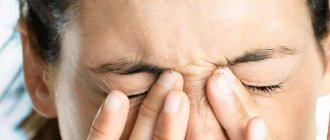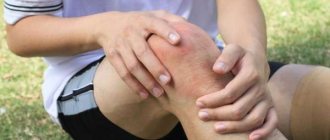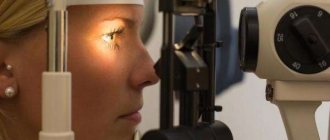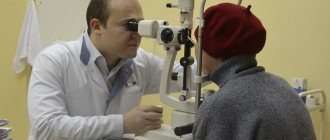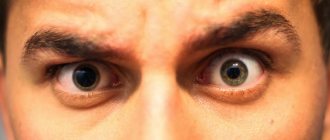In neurology, a pressing, dull headache with classic symptoms is called tension cephalgia (tension headache). The pain is dull, accompanied by a feeling of pressure, usually localized diffusely on both sides of the skull. Relatively often, during an attack, a person experiences pressure on his temples and feels dizzy. Why is this happening?
Why do spasms occur in the temples?
What hurts during a headache attack? The bones of the skull and brain tissue never hurt because they are not supplied with nerve fibers that carry pain. On the contrary, the nerve connections and nerves located between the skin and the cranial bones are painful. The muscles and blood vessels in the brain, as well as those that supply the tissues of the extracranial bones, can hurt.
Painful nerve endings are called nociceptors, and can be stimulated by stress, muscle tension, vasodilation and other provoking factors. The stimulated nociceptor sends a signal to nerve cells in the brain, telling it which part of the body is affected. For example, a person suddenly becomes aware of pain in his toe when the nociceptors in that area are stimulated.
Many chemicals help to convey pain information. Some of them are painkillers, called endorphins (from Greek: “morphine within”). One theory is that people who suffer from headaches have lower levels of endorphins than people who don't have headaches.
Headache in the eye area
There are 5 main causes of pain pressing on the eyes.
Overwork. The phenomenon is common and very familiar. If you sit in front of a laptop or TV screen for a long time, your eyes will get tired and an unhealthy feeling will appear.
Intracranial pressure. A very unpleasant cause of headaches pressing on the eyes. The most common symptoms are general weakness, dizziness, and spots in the eyes.
In addition, the heart rate may increase, a feeling of nausea and noise in the head may appear, and blood pressure may increase.
Incorrect selection of glasses. If the optical power of the lenses is greater than what vision requires, then pain may occur somewhere in the 2nd half of the day. This is due to the fact that the visual system needs to be constantly strained to provide the required level of vision.
Head injury. If, after the injury, headaches appear pressing on the eyes, it is most likely a concussion.
High blood pressure. A sure sign of increased blood pressure is increased headache when coughing or sneezing. You should consult a doctor immediately.
In other cases, a headache pressing on the eyes may be a symptom of a serious illness, for example, meningitis or encephalitis. In the first case, in addition to pain, there will be high fever, nausea and vomiting.
To check for the disease, you need to try to touch your chin to your chest. A healthy person can do this. In the 2nd, a throbbing, incessant pain will begin.
Tension pain - causes, symptoms
Frequent pain and throbbing can be caused by tension in the neck muscles, located in the area from the cervical spine throughout the entire head area, attached to the eyebrows and temples. Therefore, during muscle strain, the temples are pressed, and not the other part of the head.
Often the reason why temples hurt is the result of working on a computer, so when it occurs, it is important to stop working and do a massage to relax the muscles.
Important! If there is pressure on your temples and you feel dizzy due to prolonged viewing of the monitor, anti-inflammatory drugs based on Paracetamol will help.
This is not a life-threatening problem, but tension cephalgia is often combined with migraine attacks. In this case, it is said that there is a mixed headache; it is more complex and involves treatment of both diagnoses. It is easy to distinguish tension headaches from migraines: in the first case the pain is bilateral, in case of a migraine attack it is unilateral (the right temple or the left one hurts).
Most often, pain in the temples and dizziness occur in more sensitive, receptive, and tense people. The disease is often combined with anxiety, depression, and sleep disorders.
Sarcoidosis
The eyes become red and inflamed. If the liver, kidneys, and salivary glands are affected during the disease, intoxication develops. Shooting pains appear in the head, they occur with certain movements, sometimes there is dizziness and difficulty swallowing.
Discomfort in the temporal region can occur due to muscle spasms, involvement of nerves, and lymph nodes. The eyes are painful, the color of the conjunctiva changes, the cornea and retinal vessels become inflamed.
Acute, severe pain in the eye is bursting, aching in nature. With the development of uveitis accompanying sarcoidosis, transient pain and bilateral swelling of the optic discs are observed. With discomfort in the right temple and eyes, the patient cannot look to the side. Many luminous points are formed, making it difficult to distinguish the faces of passers-by.
Sarcoidosis
Often a person complains of night attacks that last 1-2 minutes, sometimes he may lose consciousness. Pressing pain in the left temple intensifies with simultaneous exacerbation of cervical osteochondrosis and hypoplasia of the left vertebral artery.
Nature of spasms and additional symptoms
Symptoms include a dull ache and sometimes increased tension in the head and neck. Soreness – pressing or squeezing, usually without other symptoms.
The onset of the disease is gradual, the intensity of symptoms may fluctuate slightly. As a rule, there is a feeling of pressure, as if the head is being squeezed, for example, by a tight headdress. The pain is bilateral, sometimes felt all over the head.
The intensity of the attack does not increase with physical activity and rarely forces a person to lie down. Unlike migraines, they are not accompanied by nausea or vomiting, but slight weakness may occur.
Panic during VSD is the cause of the disease
When the weather changes, on days of increased solar activity, and when the general routine and rhythms of life are disrupted, a patient with dystonia experiences throbbing pain that affects the temples and eyes at the same time. Increased sensitivity to light, sounds, and smells appears.
The patient characterizes the unpleasant sensations as a feeling of constant painful tension in the brain, which seems to be pierced by a sharp arrow, and a hot nail has been placed in the eyes.
With an increase in atmospheric pressure, a patient suffering from VSD begins to experience flickering “floaters”, the eyes are tense, and one-sided pain develops, sometimes very unusual.
Tension is felt in the temples; often, with the help of palpation, the location of increased pulsation in the temporal arteries is determined; sometimes the pain can radiate to the occipital or frontal region, accompanied by nausea, vomiting, and dizziness.
Some patients experience constant intense discomfort in the temporal region. The patient presents numerous complaints of neurotic manifestations:
- insomnia;
- tearfulness;
- decreased performance.
Symptoms of vegetative-vascular dystonia
External and internal factors that provoke spasms in the temples
The cause of a headache is not easy to determine. Soreness as such is only a symptom, that is, a manifestation of the underlying disorder. One type of cephalalgia in different conditions, time frames, situations can have several different causes. In the occurrence of the most common headache, tension headache, the psyche plays a significant role (internal tension, fatigue, anxiety, leading to increased tension in the neck muscles).
The causative factor may be:
- stress;
- lack or prolonged absence of sleep;
- uncomfortable position while working;
- poor posture;
- irregular eating (or hunger);
- eye strain.
External factors:
- intoxication – in particular, carbon monoxide poisoning;
- prolonged hunger (more than a day);
- staying at altitude (above 3 km) – compresses the temples due to lack of oxygen;
- airplane flights – the cause of pain in the temples and dizziness is an increase in intracranial pressure.
Oculomotor nerve neuropathy
After trauma, neuroinfection, stroke or due to the development of a malignant tumor, the oculomotor nerve is affected. Diabetic neuropathy occurs with intense headaches in the temporal region. The palpebral fissure narrows almost completely. There are lumbagoes that occur spontaneously or in a certain position of the head.
Changes in muscles and nerves contribute to the development of crises limited to the temporal region. Tumor processes cause disturbances in the pathways, pain radiates to the eyes, and the frequency of paroxysms varies.
With collagenosis and vasculitis, ischemic optic neuropathy develops. The patient experiences a sudden feeling of discomfort and pressure in the eyeball, loss of the upper and lower half of the visual field.
Neuropathy of the third pair of cranial nerves in a patient with diabetes mellitus occurs with increased intracranial pressure and intense pain in half of the head. He experiences severe spasms in the right side of his face, spreading from the temple up to the eye, and then down to the place where the jaws close. The doctor determines neuropathy of the abducens nerve due to a neuroinfection.
Optic neuritis
Pain prevention
To prevent pressure and pain in the temples and dizziness, you can try the following measures:
- reducing emotional and physical stress - deep breathing, meditation, muscle relaxation;
- relaxation of the head, neck, shoulders;
- exercise several times a week (be careful not to overdo it - too much exercise can cause pain, pressure in the temples, and increase dizziness);
- sufficient sleep;
- nicotine cessation;
- regular healthy eating;
- adherence to a rest schedule - a regimen can help reduce the number of stressful situations that cause dizziness, soreness and pressure in the temples;
- limiting caffeine – although some medications contain caffeine, consuming it in the form of drinks (coffee, chocolate, Coca-Cola) may cause discomfort;
- taking medication in accordance with medical recommendations.
Do not underestimate blood pressure, pain in the temples, dizziness, and seek specialized help if unusual symptoms appear. An examination is necessary if discomfort occurs more than once a week or lasts longer than a day.
Intracranial pressure
Poor circulation of cerebrospinal fluid is typical for the following diseases:
- necrotizing encephalitis;
- epilepsy;
- subarachnoid hemorrhage;
- meningitis;
- flu
Headache in the temple area, radiating to the left eye, is associated with increasing signs of intracranial hypertension and congestion in the corners of the optic nerves in acute encephalitis.
In the case of the development of periaxial Schilder encephalitis (diffuse sclerosis), the patient experiences pressing pain, impaired accommodation, and atrophy of the optic nerves. In the acute phase, the patient feels discomfort in the temporal region, intracranial pressure is increased.
Partial simple seizures in epilepsy are characterized by impaired visual sensations, pain in the eye and temple, and dizziness. As a result of a mild concussion, pain appears in the temporal region and oculomotor disturbances are observed.
After a hemorrhagic stroke, patients complain of cephalalgia, swelling and pressure in the eye area. With hydrocephalus, the patient feels an unpleasant feeling of pressure in the cranial area, which intensifies after mental stress.
Treatment of headaches, basic methods
So, it became clear to everyone that pain in the frontotemporal region, accompanied by nausea, can have different foci of occurrence, based on which treatment is prescribed.
REMEMBER! Treatment of acute headaches is not just about numbing the discomfort. The main thing is to determine the cause of the disease and treat them.
Experts do not recommend self-medication, as this can only aggravate the existing health problem. If you experience regularly recurring pain, immediately contact your primary care physician who will conduct an initial examination and diagnosis.
And only after passing all the tests, finding out the exact cause of the pain in the left temple and nausea, the doctor can prescribe concomitant treatment.
However, there are cases when prompt contact with a specialist is simply impossible. Then you need to know what first aid can be provided to a sick person. Some of the most common medications that help get rid of pain are: aspirin, citramon, analgin or farmadol.
It’s great if you have a tonometer at home with which you can determine your blood pressure. Based on the results, you should take a medicine that normalizes blood pressure.
Excellent medications for the treatment of temporal pain and discomfort in the forehead area can be medications based on the component Sumatriptan.
This treatment helps to narrow blood vessels.
However, it should be remembered that such drugs should be used exclusively for therapeutic and not prophylactic purposes.
Medicines based on non-steroidal analgesics and caffeine can cope with headaches.
But even here you should be as careful as possible when taking them, because these components can cause addiction. It is recommended to strictly adhere to the instructions.
Sedatives that are made from plant components (motherwort, hawthorn, valerian, etc.) do an excellent job of eliminating headaches. But in order to get rid of nausea, you can use an old and long-proven method - taking activated carbon. Also, drugs called Metoclopramide and Cerucal will help cope with this problem.
In the process of complex treatment of headaches, the patient should avoid excessively fatty foods, which can cause nausea and vomiting. It is better at the treatment stage to give preference to a healthy diet, which involves eating low-calorie foods.
Remember that self-treatment for regular headaches and nausea is simply not acceptable. Only a qualified doctor can competently assess the patient’s condition and prescribe appropriate treatment.
You should also not ignore headaches by using conventional painkillers. A negligent attitude towards your health can lead to disastrous consequences, depending on the cause of pain.



